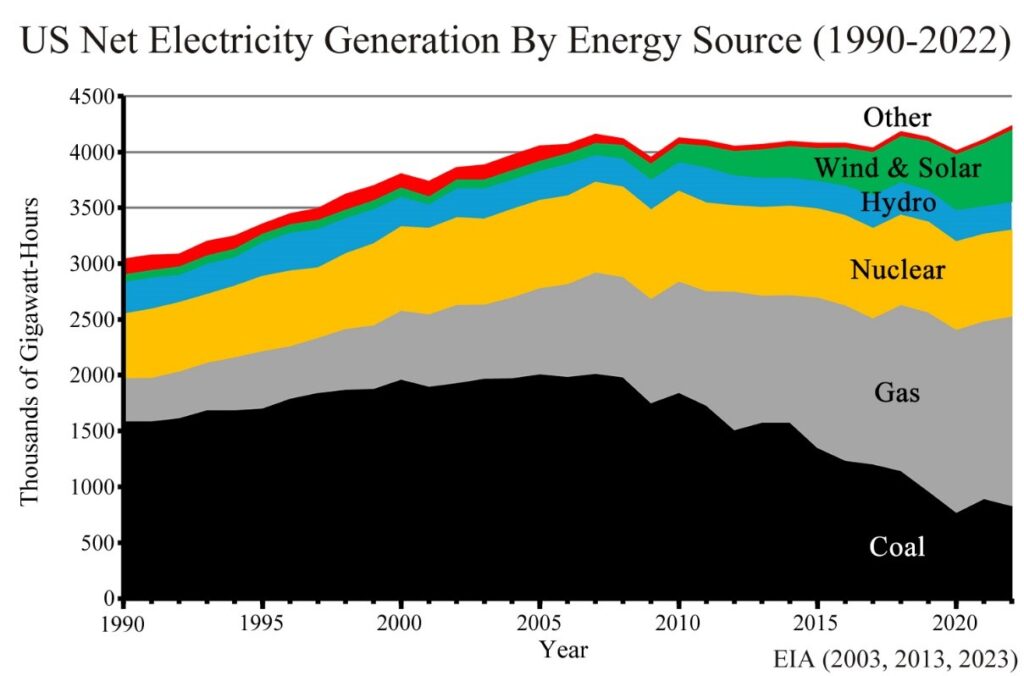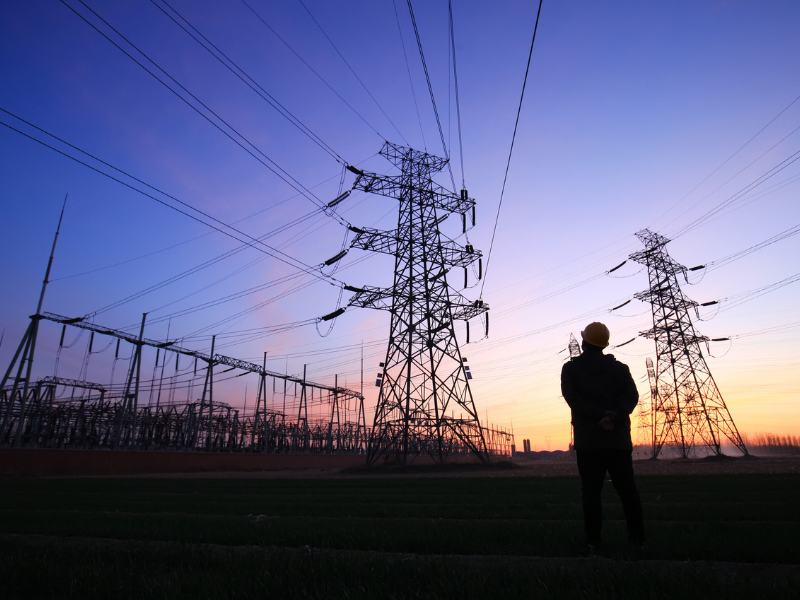Twenty-three states have adopted goals to move to 100 percent clean energy by 2050. State governments propose to retire coal- and gas-fired power plants and adopt wind and solar systems. But these goals conflict with efforts to promote electric vehicles (EVs), electric appliances, and a new rising demand for electric power.
The green energy push seeks to eliminate greenhouse gas emissions to fight human-caused global warming. Leaders tell us that without a complete transformation of electric power, transportation, and home appliances to achieve Net Zero carbon dioxide emissions, we are doomed to suffer from increasingly severe climate change impacts.
For example, Michigan passed Senate Bill 271 on December 29 of last year, as part of its “Healthy Climate Plan.” The bill requires 100 percent carbon-free electricity by 2050. Michigan’s electrical power in 2022 was generated by gas (34%), coal (29%), nuclear (22%), and wind and solar (12%).
Michigan plans to close its gas and coal plants, which provide 63 percent of the electric power, while also retiring nuclear plants. At the same time, the state wants residents to switch to EVs and electric appliances.
The Healthy Climate Plan calls for two million EVs to be on the road by 2030 along with expanded electric-powered mass transit. It calls for replacement of gas appliances with electric heat pumps. But today, more than three quarters of Michigan homes are heated with natural gas. The state is also the largest user of propane fuel for home heating.
Efforts to adopt EVs and heat pumps will produce rising electricity demand and directly conflict with efforts to close power plants. Michigan’s carbon-free electricity goals appear to be impossible to achieve.
In 2022, 60 percent of US electric power was generated by coal and natural gas. About 85 percent came from the traditional generators: gas (40%), coal (20%), nuclear (18%), and hydroelectric (6%). After two decades of subsidies, wind and solar provided only about 15 percent of US electricity.

US demand for electricity has not grown since about 2005. But the push to electrify homes and transition to EVs will usher in a new era of rising power demand.
Almost all states striving for Net Zero by 2050 will run into the problem that Michigan faces. Shutting down coal and gas plants while promoting electric vehicles and heat pumps will produce electric power shortages. The only states that may be able to approach carbon-free electricity are Idaho, Oregon, and Washington, where hydroelectric generators produce most of the power.
The New England Integrated System Operator (ISO) issued a report in 2022 that looked at four scenarios to decarbonize the New England power grid by 2040. The report projected increases in power demand from EVs and electrification of home and business heating.
Only one scenario could meet state decarbonization goals and rising demand. That scenario called for 84 gigawatts of new wind, solar, and storage, to provide 56 percent of electricity by 2040.
But the ISO concluded that such a wind-, solar-, and battery-dominated system would not be reliable, requiring periodic operator-imposed blackouts. Even with 2,400 gigawatt-hours of battery-energy capacity and system reserve margins that were 300 percent over typical electricity demand, the system would fail for an estimated 15 days, and be at risk of failure an additional 36 days each year.
Wind and solar buildouts also conflict with alarming climate forecasts. Climate warnings call for increasingly severe weather, including stronger and more frequent storms, floods, and droughts. Yet climate-policy advocates demand a switch to intermittent wind and solar electricity sources. Wind and solar typically fail to operate during heatwave, cloudy, rainy, snowy, or stormy weather conditions.
After a transition to electrified energy systems, blackouts would be more severe. When the lights go out, residents won’t be able to cook with an electric stove or drive an EV either.
Other nations also depend upon coal, gas, and oil generators for much of their electricity. Examples of hydrocarbon-produced power in 2022 were Australia (52%), China (64%), Europe (38%), India (77%), and Japan (65%). Switching to EVs and heat pumps while shuttering coal and natural gas generators will not be possible in most countries.
Two additional trends will drive electric power demand. First, the revolution in artificial intelligence (AI) requires data centers to upgrade servers with high-performance computer processors. Data center power consumption will jump by a factor of six to ten over the next decade, rising from about 1.5 percent of world power demand today to approach ten percent of world demand.
Second, governments are pushing to establish a new green hydrogen fuel business to power heavy industries such as steel. Production of green hydrogen from electrolysis of water is very electricity intensive.
The electricity required to drive electrolyzers to produce hydrogen to power a single steel plant with a four-million-ton annual capacity will require solar installations covering an area of approximately 70 square miles. About 5,000 terawatt-hours of electricity would be needed to drive electrolyzers to generate hydrogen for the world steel industry, equaling one and one-half times total non-hydroelectric global renewable electricity generated today.
The green movement calls for a shutdown of coal and gas power plants. At the same time, it demands a switch to electric vehicles, electric home appliances, and green hydrogen produced by power-intensive electrolyzers. The AI revolution will add additional electricity demand. The result will be a breakdown of the green energy transition.
Steve Goreham is a speaker on energy, the environment, and public policy and the author of the new bestselling book Green Breakdown: The Coming Renewable Energy Failure.





